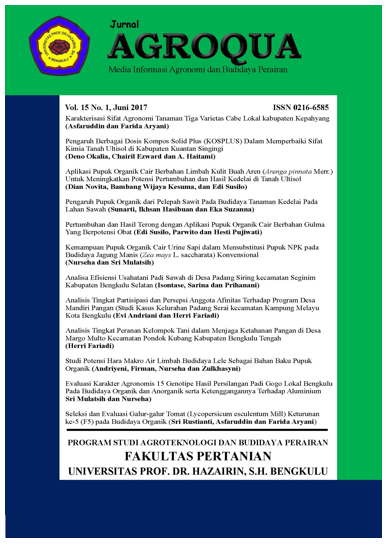PERTUMBUHAN BIBIT KELAPA SAWIT (Elaeis guineensis Jacq.) PADA MEDIA TANAM BERUPA SUBSOIL, KOMPOS TANDAN KOSONG KELAPA SAWIT DAN SEKAM PADI TAHAP MAIN-NURSERY
DOI:
https://doi.org/10.32663/ja.v19i2.2297Keywords:
EFBOP compost, oil palm seed, rice huskAbstract
The objectives of this research is to determine the composition of the planting media in the form of subsoil, empty fruit branch of oil palm (EFBOP) compost, and rice husks in the main-nursery. This research was conducted from June 2020 to September 2020 on Jl. Ciptabaru, Pematang Governor's Village, Muara Bangkahulu District, Bengkulu City, Bengkulu Province with an altitude of ±10 meters above sea level. This study used a completely randomized design (CRD) with one factor and three replications, which consisted of 11 treatments, namely M0 (100% Topsoil), M1 (100% Subsoil), M2 (80% Subsoil + 20% EFBOP Compost), M3 ( 80% Subsoil + 20% Rice Husk), M4 (60% Subsoil + 20% EFBOP Compost + 20% Rice Husk), M5 (60% Subsoil + 10% EFBOP Compost + 30% Rice Husk), M6 (60% Subsoil + 30 %EFBOP Compost + 10% Rice Husk), M7(60% Subsoil + 40% EFBOP Compost), M8(60% Subsoil + 40% Rice Husk), M9(50% Subsoil + 50% EFBOP Compost), M10 (50% Subsoil + 50% Rice Husk). Data were analized using Analysis of Variance and continued by Duncan’s Multiple Range Test at the 5% significance level. The result showed that the best planting medium is 50% subsoil + 50% EFBOP compost which produces a stem diameter of 51.02 mm, a total leaf area of ??8094.71 cm2, a greenish level of 59.15 , a dry shoot weight of 129.38 g, a dry root weight of 27.53 g.
References
Downloads
Published
Issue
Section
License
Authors who publish with this journal agree to the following terms:
- Authors grant the journal right of first publication with the work simultaneously licensed under a Creative Commons Attribution 4.0 Internasional (CC BY 4.0) Licence that allows others to use and share the work with an acknowledgment of the work's authorship and initial publication in this journal.
- The author(s) still hold the copyright of his/her/their work and retain publishing rights without restrictions such as (but not limited to) patent right, lecture, book and reproduce the article for own purposes.
















